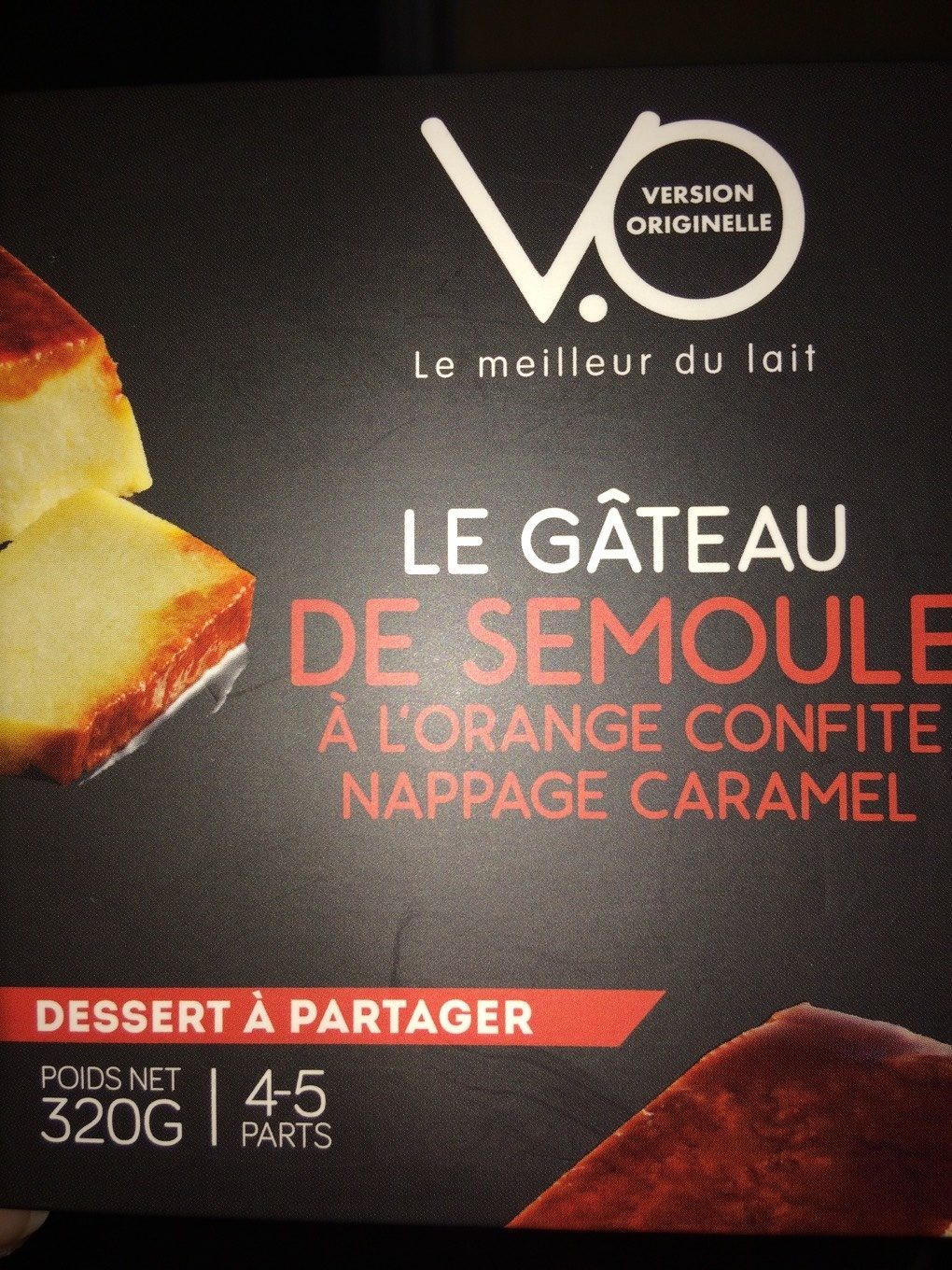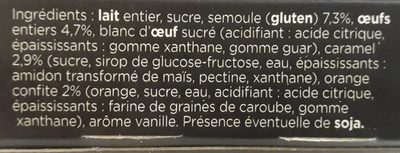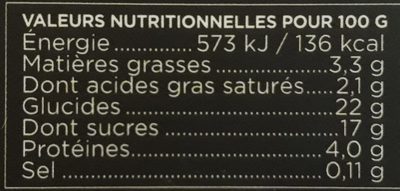Help us make food transparency the norm!
As a non-profit organization, we depend on your donations to continue informing consumers around the world about what they eat.
The food revolution starts with you!
Gâteau de Semoule à l’Orange Confite Nappage Caramel - Version Originelle - 320 g
Gâteau de Semoule à l’Orange Confite Nappage Caramel - Version Originelle - 320 g
This product page is not complete. You can help to complete it by editing it and adding more data from the photos we have, or by taking more photos using the app for Android or iPhone/iPad. Thank you!
×
Barcode: 3247330001483 (EAN / EAN-13)
Quantity: 320 g
Packaging: Plastic, Cardboard, Fresh, Refrigerated
Brands: Version Originelle, V.O, Laiterie du Forez
Categories: Dairies, Desserts, Dairy desserts, fr:Gâteaux de semoule
Labels, certifications, awards:
No preservatives, Green Dot, No colorings, Triman

Traceability code: FR 42.199.001 CE - Saint-André-d'Apchon (Loire, France), FR 42.299.001 CE - Savigneux (Loire, France)
Countries where sold: France
Matching with your preferences
Health
Ingredients
-
28 ingredients
: Lait entier, sucre, semoule (gluten) 7,3%, œufs entiers 4,7 %, blanc d'œuf sucré (acidifiant : acide citrique, épaississants gomme xanthane, gomme guar), caramel 2,9 % (sucre, sirop de glucose-fructose, eau, épaississants : amidon transformé de maïs, pectine, xanthane), orange confite 2 % (orange, sucre, eau, acidifiant : acide citrique, épaississants : farine de graines de caroube, gomme xanthane), arôme vanille.Allergens: Eggs, Gluten, Milk, OrangeTraces: Soybeans
Food processing
-
Ultra processed foods
Elements that indicate the product is in the 4 - Ultra processed food and drink products group:
- Additive: E14XX - Modified Starch
- Additive: E412 - Guar gum
- Additive: E415 - Xanthan gum
- Additive: E440 - Pectins
- Ingredient: Flavouring
- Ingredient: Glucose
- Ingredient: Thickener
Food products are classified into 4 groups according to their degree of processing:
- Unprocessed or minimally processed foods
- Processed culinary ingredients
- Processed foods
- Ultra processed foods
The determination of the group is based on the category of the product and on the ingredients it contains.
Additives
-
E330 - Citric acid
Citric acid is a natural organic acid found in citrus fruits such as lemons, oranges, and limes.
It is widely used in the food industry as a flavor enhancer, acidulant, and preservative due to its tart and refreshing taste.
Citric acid is safe for consumption when used in moderation and is considered a generally recognized as safe (GRAS) food additive by regulatory agencies worldwide.
-
E412 - Guar gum
Guar gum (E412) is a natural food additive derived from guar beans.
This white, odorless powder is valued for its remarkable thickening and stabilizing properties, making it a common ingredient in various food products, including sauces, dressings, and ice creams.
When used in moderation, guar gum is considered safe for consumption, with no known adverse health effects.
-
E415 - Xanthan gum
Xanthan gum (E415) is a natural polysaccharide derived from fermented sugars, often used in the food industry as a thickening and stabilizing agent.
This versatile food additive enhances texture and prevents ingredient separation in a wide range of products, including salad dressings, sauces, and gluten-free baked goods.
It is considered safe for consumption even at high intake amounts.
-
E440 - Pectins
Pectins (E440) are natural carbohydrates, predominantly found in fruits, that act as gelling agents in the food industry, creating the desirable jelly-like texture in jams, jellies, and marmalades.
Pectins stabilize and thicken various food products, such as desserts, confectioneries, and beverages, ensuring a uniform consistency and quality.
Recognized as safe by various health authorities, pectins have been widely used without notable adverse effects when consumed in typical dietary amounts.
Ingredients analysis
-
Palm oil free
No ingredients containing palm oil detected
-
Non-vegan
Non-vegan ingredients: Whole milk, Whole egg, Egg white
-
Maybe vegetarian
Ingredients that may not be vegetarian: Vanilla flavouring
-
Details of the analysis of the ingredients
: _Lait_ entier, sucre, semoule 7.3%, _œufs_ entiers 4.7%, blanc d'_œuf_ (acidifiant (acide citrique), épaississants (gomme xanthane), gomme guar), caramel 2.9% (sucre, sirop de glucose-fructose, eau, épaississants (amidon transformé de maïs), pectine, xanthane), orange 2% (orange, sucre, eau, acidifiant (acide citrique), épaississants (farine de graines de caroube), gomme xanthane), arôme vanille- _Lait_ entier -> en:whole-milk - vegan: no - vegetarian: yes - ciqual_food_code: 19023 - percent_min: 59.4 - percent_max: 72.9
- sucre -> en:sugar - vegan: yes - vegetarian: yes - ciqual_proxy_food_code: 31016 - percent_min: 7.3 - percent_max: 17
- semoule -> en:semolina - vegan: yes - vegetarian: yes - ciqual_proxy_food_code: 9410 - percent_min: 7.3 - percent: 7.3 - percent_max: 7.3
- _œufs_ entiers -> en:whole-egg - vegan: no - vegetarian: yes - ciqual_food_code: 22000 - percent_min: 4.7 - percent: 4.7 - percent_max: 4.7
- blanc d'_œuf_ -> en:egg-white - vegan: no - vegetarian: yes - ciqual_food_code: 22001 - percent_min: 2.9 - percent_max: 4.7
- acidifiant -> en:acid - percent_min: 0.966666666666667 - percent_max: 4.7
- acide citrique -> en:e330 - vegan: yes - vegetarian: yes - percent_min: 0.966666666666667 - percent_max: 4.7
- épaississants -> en:thickener - percent_min: 0 - percent_max: 2.35
- gomme xanthane -> en:e415 - vegan: yes - vegetarian: yes - percent_min: 0 - percent_max: 2.35
- gomme guar -> en:e412 - vegan: yes - vegetarian: yes - percent_min: 0 - percent_max: 1.56666666666667
- acidifiant -> en:acid - percent_min: 0.966666666666667 - percent_max: 4.7
- caramel -> en:e150 - vegan: yes - vegetarian: yes - percent_min: 2.9 - percent: 2.9 - percent_max: 2.9
- sucre -> en:sugar - vegan: yes - vegetarian: yes - ciqual_proxy_food_code: 31016 - percent_min: 0.483333333333333 - percent_max: 2.9
- sirop de glucose-fructose -> en:glucose-fructose-syrup - vegan: yes - vegetarian: yes - ciqual_food_code: 31077 - percent_min: 0 - percent_max: 1.45
- eau -> en:water - vegan: yes - vegetarian: yes - ciqual_food_code: 18066 - percent_min: 0 - percent_max: 0.966666666666667
- épaississants -> en:thickener - percent_min: 0 - percent_max: 0.725
- amidon transformé de maïs -> en:modified-corn-starch - vegan: yes - vegetarian: yes - ciqual_food_code: 9510 - percent_min: 0 - percent_max: 0.725
- pectine -> en:e440a - vegan: yes - vegetarian: yes - percent_min: 0 - percent_max: 0.58
- xanthane -> en:e415 - vegan: yes - vegetarian: yes - percent_min: 0 - percent_max: 0.483333333333333
- orange -> en:orange - vegan: yes - vegetarian: yes - ciqual_proxy_food_code: 13034 - percent_min: 2 - percent: 2 - percent_max: 2
- orange -> en:orange - vegan: yes - vegetarian: yes - ciqual_proxy_food_code: 13034 - percent_min: 0.333333333333333 - percent_max: 2
- sucre -> en:sugar - vegan: yes - vegetarian: yes - ciqual_proxy_food_code: 31016 - percent_min: 0 - percent_max: 1
- eau -> en:water - vegan: yes - vegetarian: yes - ciqual_food_code: 18066 - percent_min: 0 - percent_max: 0.666666666666667
- acidifiant -> en:acid - percent_min: 0 - percent_max: 0.5
- acide citrique -> en:e330 - vegan: yes - vegetarian: yes - percent_min: 0 - percent_max: 0.5
- épaississants -> en:thickener - percent_min: 0 - percent_max: 0.4
- farine de graines de caroube -> en:carob-seed-flour - vegan: yes - vegetarian: yes - ciqual_proxy_food_code: 9410 - percent_min: 0 - percent_max: 0.4
- gomme xanthane -> en:e415 - vegan: yes - vegetarian: yes - percent_min: 0 - percent_max: 0.4
- arôme vanille -> en:vanilla-flavouring - vegan: maybe - vegetarian: maybe - percent_min: 0 - percent_max: 2
Nutrition
-
Average nutritional quality
⚠ ️Warning: the amount of fiber is not specified, their possible positive contribution to the grade could not be taken into account.⚠ ️Warning: the amount of fruits, vegetables and nuts is not specified on the label, it was estimated from the list of ingredients: 1This product is not considered a beverage for the calculation of the Nutri-Score.
Positive points: 2
- Proteins: 2 / 5 (value: 4, rounded value: 4)
- Fiber: 0 / 5 (value: 0, rounded value: 0)
- Fruits, vegetables, nuts, and colza/walnut/olive oils: 0 / 5 (value: 1.16666666666667, rounded value: 1.2)
Negative points: 6
- Energy: 1 / 10 (value: 569, rounded value: 569)
- Sugars: 3 / 10 (value: 17, rounded value: 17)
- Saturated fat: 2 / 10 (value: 2.1, rounded value: 2.1)
- Sodium: 0 / 10 (value: 40, rounded value: 40)
The points for proteins are counted because the negative points are less than 11.
Nutritional score: (6 - 2)
Nutri-Score:
-
Nutrient levels
-
Fat in moderate quantity (3.3%)
What you need to know- A high consumption of fat, especially saturated fats, can raise cholesterol, which increases the risk of heart diseases.
Recommendation: Limit the consumption of fat and saturated fat- Choose products with lower fat and saturated fat content.
-
Saturated fat in moderate quantity (2.1%)
What you need to know- A high consumption of fat, especially saturated fats, can raise cholesterol, which increases the risk of heart diseases.
Recommendation: Limit the consumption of fat and saturated fat- Choose products with lower fat and saturated fat content.
-
Sugars in high quantity (17%)
What you need to know- A high consumption of sugar can cause weight gain and tooth decay. It also augments the risk of type 2 diabetes and cardio-vascular diseases.
Recommendation: Limit the consumption of sugar and sugary drinks- Sugary drinks (such as sodas, fruit beverages, and fruit juices and nectars) should be limited as much as possible (no more than 1 glass a day).
- Choose products with lower sugar content and reduce the consumption of products with added sugars.
-
Salt in low quantity (0.1%)
What you need to know- A high consumption of salt (or sodium) can cause raised blood pressure, which can increase the risk of heart disease and stroke.
- Many people who have high blood pressure do not know it, as there are often no symptoms.
- Most people consume too much salt (on average 9 to 12 grams per day), around twice the recommended maximum level of intake.
Recommendation: Limit the consumption of salt and salted food- Reduce the quantity of salt used when cooking, and don't salt again at the table.
- Limit the consumption of salty snacks and choose products with lower salt content.
-
-
Nutrition facts
Nutrition facts As sold
for 100 g / 100 mlCompared to: fr:Gâteaux de semoule Energy 569 kj
(136 kcal)-7% Fat 3.3 g +6% Saturated fat 2.1 g +14% Carbohydrates 22 g -11% Sugars 17 g +4% Fiber ? Proteins 4 g +9% Salt 0.1 g -7% Fruits‚ vegetables‚ nuts and rapeseed‚ walnut and olive oils (estimate from ingredients list analysis) 1.167 %
Environment
-
Eco-Score B - Low environmental impact
⚠ ️Select a country in order to include the full impact of transportation.The Eco-Score is an experimental score that summarizes the environmental impacts of food products.→ The Eco-Score was initially developped for France and it is being extended to other European countries. The Eco-Score formula is subject to change as it is regularly improved to make it more precise and better suited to each country.Life cycle analysis
-
Average impact of products of the same category: A (Score: 91/100)
Category: Semolina pudding, canned
Category: Semolina pudding, canned
- PEF environmental score: 0.19 (the lower the score, the lower the impact)
- including impact on climate change: 1.50 kg CO2 eq/kg of product
Stage Impact Agriculture
62.6 %Processing
19.4 %Packaging
8.6 %Transportation
5.5 %Distribution
2.5 %Consumption
1.3 %
Bonuses and maluses
-
Missing origins of ingredients information
Malus: -5
⚠ ️ The origins of the ingredients of this product are not indicated.
If they are indicated on the packaging, you can modify the product sheet and add them.
If you are the manufacturer of this product, you can send us the information with our free platform for producers.
-
Packaging with a medium impact
Malus: -11
Shape Material Recycling Impact Unknown Plastic High Unknown Cardboard Low ⚠ ️ The information about the packaging of this product is not sufficiently precise (exact shapes and materials of all components of the packaging).⚠ ️ For a more precise calculation of the Eco-Score, you can modify the product page and add them.
If you are the manufacturer of this product, you can send us the information with our free platform for producers.
Eco-Score for this product
-
Impact for this product: B (Score: 75/100)
Product: Gâteau de Semoule à l’Orange Confite Nappage Caramel - Version Originelle - 320 g
Life cycle analysis score: 91
Sum of bonuses and maluses: -16
Final score: 75/100
-
Carbon footprint
-
Equal to driving 0.8 km in a petrol car
150 g CO² per 100g of product
The carbon emission figure comes from ADEME's Agribalyse database, for the category: Semolina pudding, canned (Source: ADEME Agribalyse Database)
Stage Impact Agriculture
63.5 %Processing
14.1 %Packaging
12.2 %Transportation
8.6 %Distribution
1.2 %Consumption
0.4 %
Packaging
-
Packaging with a medium impact
-
Packaging parts
(Plastic)
(Cardboard)
-
Packaging materials
Material % Packaging weight Packaging weight per 100 g of product Paper or cardboard Plastic Total
-
Transportation
-
Origins of ingredients
Missing origins of ingredients information
⚠ ️ The origins of the ingredients of this product are not indicated.
If they are indicated on the packaging, you can modify the product sheet and add them.
If you are the manufacturer of this product, you can send us the information with our free platform for producers.Add the origins of ingredients for this product Add the origins of ingredients for this product
Report a problem
-
Incomplete or incorrect information?
Category, labels, ingredients, allergens, nutritional information, photos etc.
If the information does not match the information on the packaging, please complete or correct it. Open Food Facts is a collaborative database, and every contribution is useful for all.
Data sources
Product added on by kiliweb
Last edit of product page on by packbot.
Product page also edited by asmoth, beniben, openfoodfacts-contributors, roboto-app, yuka.UTRRc0U3NERsc0Vzb2NCZ3dESFhxdXdrMTZLcUJHK3RkY3NXSWc9PQ, yuka.WklNQVFiZ09oTWNRa2NVNDh4UGsvL3RKNHAyVVYyMnBBZlVJSVE9PQ, yuka.WnFJcUcvVTV0OWt0eHZNKzdrM3kzTmx6eGJ1NGVtYXZEZThOSWc9PQ.











